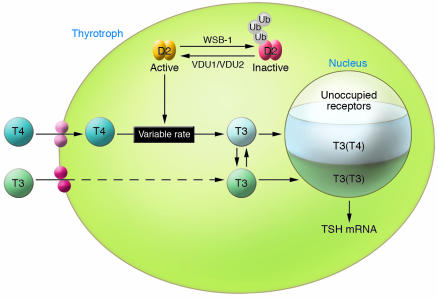Figure 3. Role of D2 in TSH feedback.
In the thyrotroph, TSH is subject to negative feedback by T3, which arrives in the nucleus from 2 distinct sources: plasma T3, illustrated as T3(T3); and plasma T4, which is then converted to T3 intracellularly via the D2 pathway, represented as T3(T4). The schematic includes the plasma membrane, which contains thyroid hormone transporters (indicated by the pink and red circles); the cytoplasm, containing the enzymes involved in thyroid hormone metabolism; and the nucleus, containing the TRs. D2 is represented in active form (yellow) and inactive form (red). Transition between active and inactive D2 is via ubiquitination and deubiquitination, reactions that are catalyzed by WSB-1 and VDU1/VDU2, respectively. As a result of ubiquitination, D2-mediated T4-to-T3 conversion occurs at variable rates, decreasing as serum T4 concentration increases (46). Ultimately, these processes determine nuclear TR saturation, which includes contributions from both T3(T3) and T3(T4) as indicated, with only a minor fraction of the TRs being unoccupied under normal conditions. Ub, Ubiquitin. Figure modified with permission from Endocrine Reviews (14).

